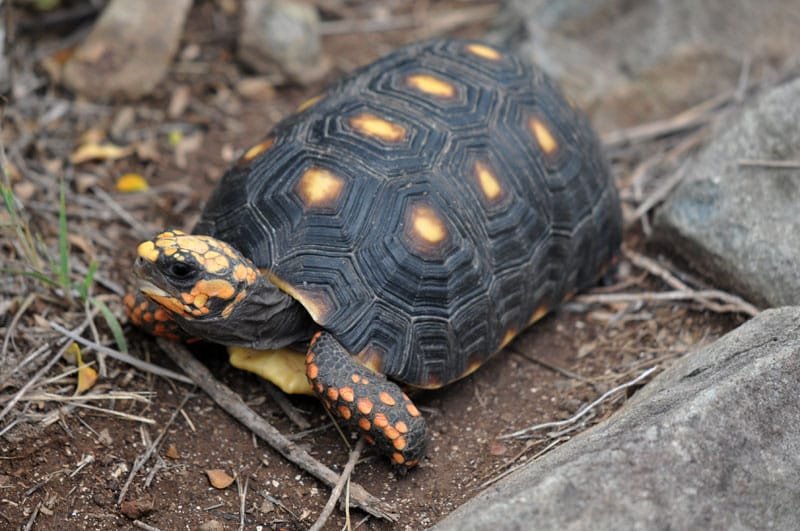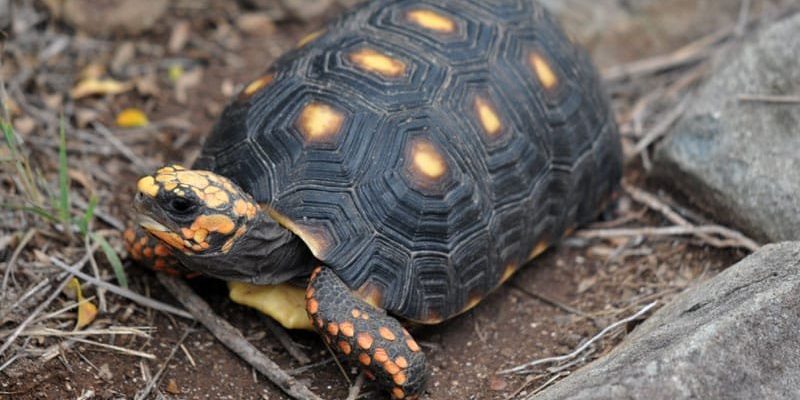
These tortoises are native to the lush forests and grassy areas of South America, particularly in countries like Brazil, Guyana, and Venezuela. Their bright, red-orange markings on their limbs and shells make them stand out, almost like nature’s little pieces of art. Whether you’re a curious pet owner, a nature enthusiast, or simply someone who loves learning about animals, understanding how to identify a red-footed tortoise can be both fun and rewarding. So, let’s dive in and explore the unique features that set these tortoises apart!
Physical Characteristics of Red-Footed Tortoises
To spot a red-footed tortoise, you’ll first want to check out its shell. These tortoises have a high domed shell that’s typically dark brown or black. What really makes them pop, though, are the bright red or orange patterns on their limbs, head, and sometimes even on the shell itself! It’s like putting on a dazzling outfit that gets heads turning.
Their average size can range from about 10 to 14 inches in shell length, although some can grow larger. You might notice their short tail and sturdy legs, which help them navigate their natural habitats. All these features come together to create a distinct look that’s hard to miss. If you see a tortoise with those characteristics, you can be pretty confident you’ve identified a red-footed tortoise.
Color Patterns and Skin Texture
One of the most beautiful aspects of the red-footed tortoise is its coloration. The various hues can vary depending on the individual tortoise and its environment. In general, look for that rich, dark shell contrasting with vivid orange-red patches. It’s like a perfectly brewed cup of espresso topped with a sprinkle of cinnamon; warm, inviting, and eye-catching.
The skin of these tortoises is also notable—it’s often a mix of dark brown and yellow tones, with the legs and head showcasing those striking red-orange scales. This coloration plays a role in their ability to blend into the leafy underbrush of their natural habitats. So, if you’re trying to spot one in the wild, keep an eye out not just for the shell but also for the vibrant skin that peeks through the foliage.
Behavior and Personality Traits
Now, let’s chat about the tortoise’s personality. Red-footed tortoises are known for being quite friendly, especially compared to other reptiles. If you’re lucky enough to interact with one, you might find it’s not shy at all! These tortoises can be quite curious and will often approach people, perhaps wondering if you have any snacks to share.
In the wild, these tortoises are terrestrial, spending their days roaming around searching for food. They are social creatures and can even live in small groups. If you decide to keep one as a pet, you’ll find they have personalities that can be quite charming, sometimes even showing affection. So, if you see a tortoise that seems intrigued by your presence, you might just be meeting a red-footed tortoise!
Habitat Preferences
Red-footed tortoises thrive in tropical and subtropical environments. They often prefer areas with plenty of vegetation, which provides both food and cover from predators. Think of them as nature’s gardeners; they play an important role by munching on plants, which helps maintain their ecosystems.
When identifying a red-footed tortoise in the wild, look for them in habitats like rainforests, grasslands, and even savannas. You’ll often find them in moist areas close to water sources, such as rivers or ponds. If you’ve got a tortoise in a garden, ensuring some leafy greens and a little water nearby will keep it feeling right at home!
Diet: What Do They Eat?
Understanding a red-footed tortoise’s diet is essential for keeping one healthy. They’re herbivores, which means their diet mainly consists of plants. Think of them as little munching machines, happily chowing down on a mix of fruits, vegetables, and leafy greens.
Some favorites include:
- Fruits: Papaya, melon, and banana are big hits!
- Vegetables: Leafy greens like kale and collard greens are nutritious choices.
- Flowers: They enjoy edible flowers, adding some color to their meal plans.
You might be wondering how to make sure your tortoise gets the right balance. It’s best to stick to fresh, organic options, ensuring no harmful pesticides are involved. Remember, a happy tortoise is often a healthy tortoise!
Common Health Issues to Watch For
Like any pet, red-footed tortoises can face health challenges. Being aware of potential issues can help you keep your tortoise happy and thriving. One common concern is respiratory infections, which can occur if they are kept in a damp environment without proper ventilation.
You might notice symptoms like watery eyes, lethargy, or difficulty breathing. It’s essential to act quickly. Provide a warm, dry space, and if things don’t improve, consult a vet experienced with reptiles. Other health issues to look for include shell rot and parasites, both of which can be managed with proper care. So, always keep an eye on your tortoise’s well-being—prevention is key!
In summary, identifying a red-footed tortoise is like discovering a treasure trove of colors, personality, and fascinating behaviors. Whether you’re spotting one in the wild or caring for one as a pet, understanding their physical traits, habitat preferences, and diets will enrich your experience.
These tortoises are not just beautiful creatures; they also play vital roles in their ecosystems and offer companionship to those who care for them. If you ever get the chance to meet a red-footed tortoise, remember to appreciate its unique beauty and personality. You might just find a new friend in this charming reptile!

